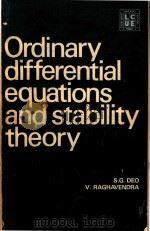《ordinary differential equations P334》
| 作者 | 编者 |
|---|---|
| 出版 | 未查询到或未知 |
| 参考页数 | |
| 出版时间 | 没有确切时间的资料 目录预览 |
| ISBN号 | 无 — 求助条款 |
| PDF编号 | 820544828(仅供预览,未存储实际文件) |
| 求助格式 | 扫描PDF(若分多册发行,每次仅能受理1册) |

Chapter 1.Basic Concepts13
1.Phase Spaces13
1.Examples of Evolutionary Processes13
2.Phase Spaces14
3.The Integral Curves of a Direction Field16
4.A Differential Equation and its Solutions17
5.The Evolutionary Equation with a One-dimensional Phase Space19
6.Example: The Equation of Normal Reproduction21
7.Example: The Explosion Equation23
8.Example: The Logistic Curve24
9.Example: Harvest Quotas25
10.Example: Harvesting with a Relative Quota26
11.Equations with a Multidimensional Phase Space27
12.Example: The Differential Equation of a Predator-Prey System28
13.Example: A Free Particle on a Line31
14.Example: Free Fall32
15.Example: Small Oscillations32
16.Example: The Mathematical Pendulum33
17.Example: The Inverted Pendulum34
18.Example: Small Oscillations of a Spherical Pendulum34
2.Vector Fields on the Line36
1.Existence and Uniqueness of Solutions36
2.A Counterexample36
3.Proof of Uniqueness37
4.Direct Products39
5.Examples of Direct Products39
6.Equations with Separable Variables41
7.An Example: The Lotka-Volterra Model43
3.Linear Equations48
1.Homogeneous Linear Equations48
2.First-order Homogeneous Linear Equations with Periodic Coefficients49
3.Inhomogeneous Linear Equations51
4.The Influence Function and δ-shaped Inhomogeneities53
5.Inhomogeneous Linear Equations with Periodic Coefficients56
4.Phase Flows57
1.The Action of a Group on a Set57
2.One-parameter Transformation Groups59
3.One-parameter Diffeomorphism Groups61
4.The Phase Velocity Vector Field63
5.The Action of Diffeomorphisms on Vector Fields and Direction Fields66
1.The Action of Smooth Mappings on Vectors66
2.The Action of Diffeomorphisms on Vector Fields70
3.Change of Variables in an Equation72
4.The Action of a Diffeomorphism on a Direction Field73
5.The Action of a Diffeomorphisms on a Phase Flow75
6.Symmetries76
1.Symmetry Groups76
2.Application of a One-parameter Symmetry Group to Integrate an Equation77
3.Homogeneous Equations79
4.Quasi-homogeneous Equations82
5.Similarity and Dimensional Considerations84
6.Methods of Integrating Differential Equations86
Chapter 2.Basic Theorems89
7.Rectification Theorems89
1.Rectification of a Direction Field89
2.Existence and Uniqueness Theorems92
3.Theorems on Continuous and Differentiable Dependence of theSolutions on the Initial Condition93
4.Transformation over the Time Interval from to to t96
5.Theorems on Continuous and Differentiable Dependence on a Parameter97
6.Extension Theorems100
7.Rectification of a Vector Field103
8.Applications to Equations of Higher Order than First104
1.The Equivalence of an Equation of Order n and a System of n First-order Equations104
2.Existence and Uniqueness Theorems107
3.Differentiability and Extension Theorems108
4.Systems of Equations109
5.Remarks on Terminology112
9.The Phase Curves of an Autonomous System116
1.Autonomous Systems117
2.Translation over Time117
3.Closed Phase Curves119
10.The Derivative in the Direction of a Vector Field and First Integrals121
1.The Derivative in the Direction of a Vector121
2.The Derivative in the Direction of a Vector Field122
3.Properties of the Directional Derivative123
4.The Lie Algebra of Vector Fields124
5.First Integrals125
6.Local First Integrals126
7.Time-Dependent First Integrals127
11.First-order Linear and Quasi-linear Partial Differential Equations129
1.The Homogeneous Linear Equation129
2.The Cauchy Problem130
3.The Inhomogeneous Linear Equation131
4.The Quasi-linear Equation132
5.The Characteristics of a Quasi-linear Equation133
6.Integration of a Quasi-linear Equation135
7.The First-order Nonlinear Partial Differential Equation136
12.The Conservative System with one Degree of Freedom138
1.Definitions138
2.The Law of Conservation of Energy139
3.The Level Lines of the Energy140
4.The Level Lines of the Energy Near a Singular Point142
5.Extension of the Solutions of Newton’s Equation144
6.Noncritical Level Lines of the Energy145
7.Proof of the Theorem of Sect.6146
8.Critical Level Lines147
9.An Example148
10.Small Perturbations of a Conservative System149
Chapter 3.Linear Systems152
13.Linear Problems152
1.Example: Linearization152
2.Example: One-parameter Groups of Linear Transformations of Rn153
3.The Linear Equation154
14.The Exponential Function155
1.The Norm of an Operator155
2.The Metric Space of Operators156
3.Proof of Completeness156
4.Series157
5.Definition of the Exponential eA158
6.An Example159
7.The Exponential of a Diagonal Operator160
8.The Exponential of a Nilpotent Operator160
9.Quasi-polynomials161
15.Properties of the Exponential162
1.The Group Property163
2.The Fundamental Theorem of the Theory of Linear Equations with Constant Coefficients164
3.The General Form of One-parameter Groups of Linear Transformations of the Space Rn165
4.A Second Definition of the Exponential165
5.An Example: Euler’s Formula for e166
6.Euler’s Broken Lines167
16.The Determinant of an Exponential169
1.The Determinant of an Operator169
2.The Trace of an Operator170
3.The Connection Between the Determinant and the Trace171
4.The Determinant of the Operator eA171
17.Practical Computation of the Matrix of an Exponential -The Case when the Eigenvalues are Real and Distinct173
1.The Diagonalizable Operator173
2.An Example174
3.The Discrete Case175
18.Complexification and Realification177
1.Realification177
2.Complexification177
3.The Complex Conjugate178
4.The Exponential, Determinant, and Trace of a Complex Operator179
5.The Derivative of a Curve with Complex Values180
19.The Linear Equation with a Complex Phase Space181
1.Definitions181
2.The Fundamental Theorem181
3.The Diagonalizable Case182
4.Example: A Linear Equation whose Phase Space is a Complex Line182
5.Corollary185
20.The Complexification of a Real Linear Equation185
1.The Complexified Equation185
2.The Invariant Subspaces of a Real Operator187
3.The Linear Equation on the Plane189
4.The Classification of Singular Points in the Plane190
5.Example: The Pendulum with Friction191
6.The General Solution of a Linear Equation in the Case when the Characteristic Equation Has Only Simple Roots193
21.The Classification of Singular Points of Linear Systems195
1.Example:Singular Points in Three-dimensional Space195
2.Linear,Differentiable, and Topological Equivalence197
3.The Linear Classification198
4.The Differentiable Classification199
22.The Topological Classification of Singular Points199
1.Theorem199
2.Reduction to the Case m _ = 0200
3.The Lyapunov Function201
4.Construction of the Lyapunov Function202
5.An Estimate of the Derivative204
6.Construction of the Homeomorphism h206
7.Proof of Lemma 3207
8.Proof of the Topological Classification Theorem208
23.Stability of Equilibrium Positions210
1.Lyapunov Stability210
2.Asymptotic Stability211
3.A Theorem on Stability in First Approximation211
4.Proof of the Theorem212
24.The Case of Purely Imaginary Eigenvalues215
1.The Topological Classification215
2.An Example215
3.The Phase Curves of Eq.(4) on the Torus217
4.Corollaries219
5.The Multidimensional Case219
6.The Uniform Distribution220
25.The Case of Multiple Eigenvalues221
1.The Computation of eat, where A is a Jordan Block221
2.Applications223
3.Applications to Systems of Equations of Order Higher than the First224
4.The Case of a Single nth-order Equation225
5.On Recursive Sequences226
6.Small Oscillations227
26.Quasi-polynomials229
1.A Linear Function Space229
2.The Vector Space of Solutions of a Linear Equation230
3.Translation-invariance231
4.Historical Remark232
5.Inhomogeneous Equations233
6.The Method of Complex Amplitudes235
7.Application to the Calculation of Weakly Nonlinear Oscillations240
27.Nonautonomous Linear Equations241
1.Definition241
2.The Existence of Solutions242
3.The Vector Space of Solutions244
4.The Wronskian Determinant245
5.The Case of a Single Equation246
6.Liouville’s Theorem248
7.Sturm’s Theorems on the Zeros of Solutions of Second-order Equations251
28.Linear Equations with Periodic Coefficients256
1.The Mapping over a Period256
2.Stability Conditions258
3.Strongly Stable Systems259
4.Computations262
29.Variation of Constants264
1.The Simplest Case264
2.The General Case264
3.Computations265
Chapter 4.Proofs of the Main Theorems267
30.Contraction Mappings267
1.Definition267
2.The Contraction Mapping Theorem268
3.Remark269
31.Proof of the Theorems on Existence and Continuous Dependence on the Initial Conditions269
1.The Successive Approximations of Picard269
2.Preliminary Estimates271
3.The Lipschitz Condition272
4.Differentiability and the Lipschitz Condition272
5.The Quantities C, L, a’, b273
6.The Metric Space M274
7.The Contraction Mapping A :M→M275
8.The Existence and Uniqueness Theorem276
9.Other Applications of Contraction Mappings277
32.The Theorem on Differentiability279
1.The Equation of Variations279
2.The Differentiability Theorem280
3.Higher Derivatives with Respect to x281
4.Derivatives in x and t281
5.The Rectification Theorem282
6.The Last Derivative285
Chapter 5.Differential Equations on Manifolds288
33.Differentiable Manifolds288
1.Examples of Manifolds288
2.Definitions288
3.Examples of Atlases291
4.Compactness293
5.Connectedness and Dimension293
6.Differentiable Mappings294
7.Remark296
8.Submanifolds296
9.An Example297
34.The Tangent Bundle.Vector Fields on a Manifold298
1.The Tangent Space298
2.The Tangent Bundle299
3.A Remark on Parallelizability301
4.The Tangent Mapping302
5.Vector Fields303
35.The Phase Flow Defined by a Vector Field304
1.Theorem304
2.Construction of the Diffeomorphisms gt for Small t305
3.The Construction of gt for any t306
4.A Remark307
36.The Indices of the Singular Points of a Vector Field309
1.The Index of a Curve309
2.Properties of the Index310
3.Examples310
4.The Index of a Singular Point of a Vector Field312
5.The Theorem on the Sum of the Indices313
6.The Sum of the Indices of the Singular Points on a Sphere315
7.Justification317
8.The Multidimensional Case318
Examination Topics323
Sample Examination Problems324
Supplementary Problems326
Subject Index331
《ordinary differential equations P334》由于是年代较久的资料都绝版了,几乎不可能购买到实物。如果大家为了学习确实需要,可向博主求助其电子版PDF文件。对合法合规的求助,我会当即受理并将下载地址发送给你。
高度相关资料
-

- Ordinary differential equations
- 1998 World Pub.Corp.
-

- ORDINARY DIFFERENTIAL EQUATIONS
- 1969年第2版 JOHN WILEY & SONS NEW YORK
-

- ORDINARY DIFFERENTIAL EQUATIONS
- 1969 JOHN WILEY & SONS NEW YORK
-

- INTRODUCTION TO ORDINARY DIFFERENTIAL EQUATIONS
- 1980 JOHN WILEY SONS
-

- SONATE FUR VIOLONCELLO SOLO=仁契:大提琴奏鸣曲
- 7 COLLECTION LITOLFF
-

- Nonlinear ordinary differential equations
- 1977 Clarendon Press
-

- Ordinary differential equations
- 1971 Holden-Day
-

- Introduction to ordinary differential equations /
- 1982 Harcourt Brace Jovanovich
-

- Ordinary differential equations Second Edition
- 1980 R.E.Krieger Pub.Co.
-

- Ordinary differential equations
- 1926 Dover Publications
-

- Ordinary differential equations
- 1978 Elsevier North-Holland
-

- Ordinary and delay differential equations
- 1977 Springer-Verlag
-

- Ordinary differential equations and stability theory
- 1980 Tata McGraw-Hill
-

- ORDINARY DIFFERENTIAL EQUATIONS
- 1973 THE MASSACHUSETTS INSTITUTE OF TECHNOLOGY
-

- LECTURES ON ORDINARY DIFFERENTIAL EQUATIONS
- 1970 ACADEMIC PRESS
提示:百度云已更名为百度网盘(百度盘),天翼云盘、微盘下载地址……暂未提供。➥ PDF文字可复制化或转WORD